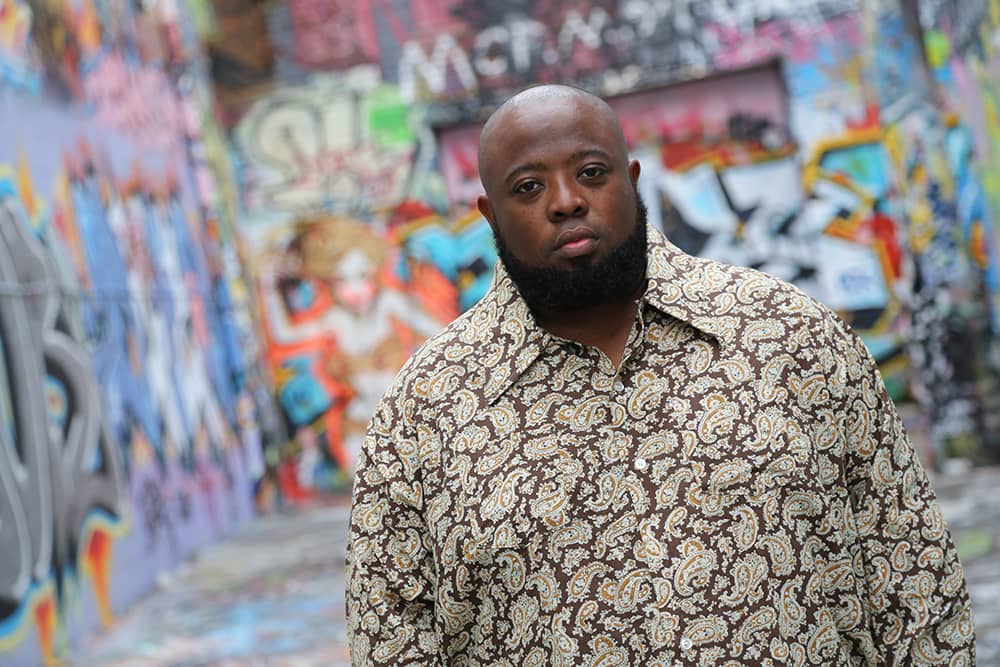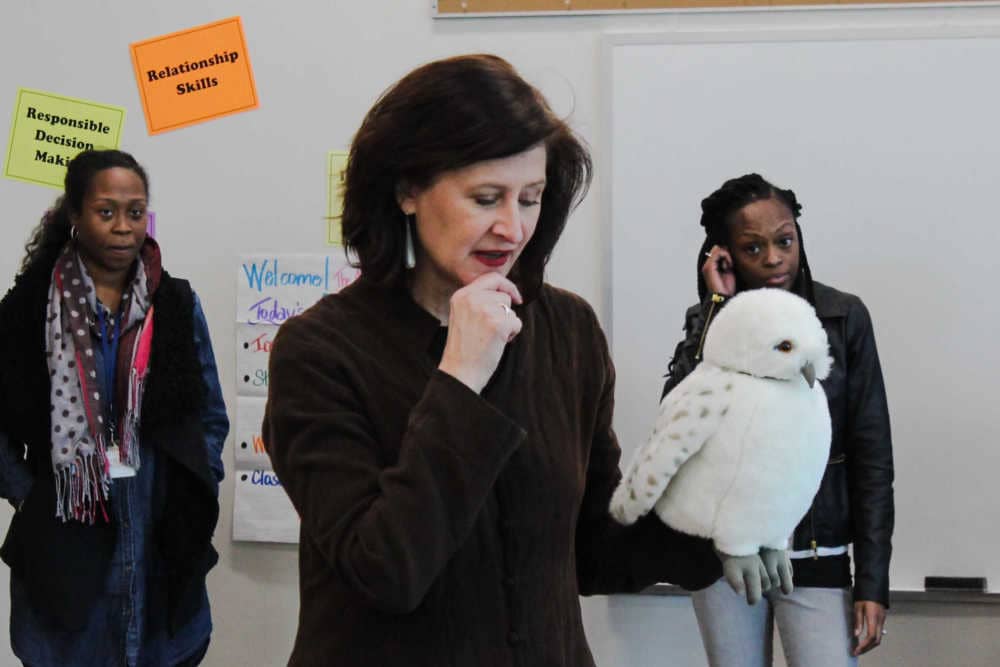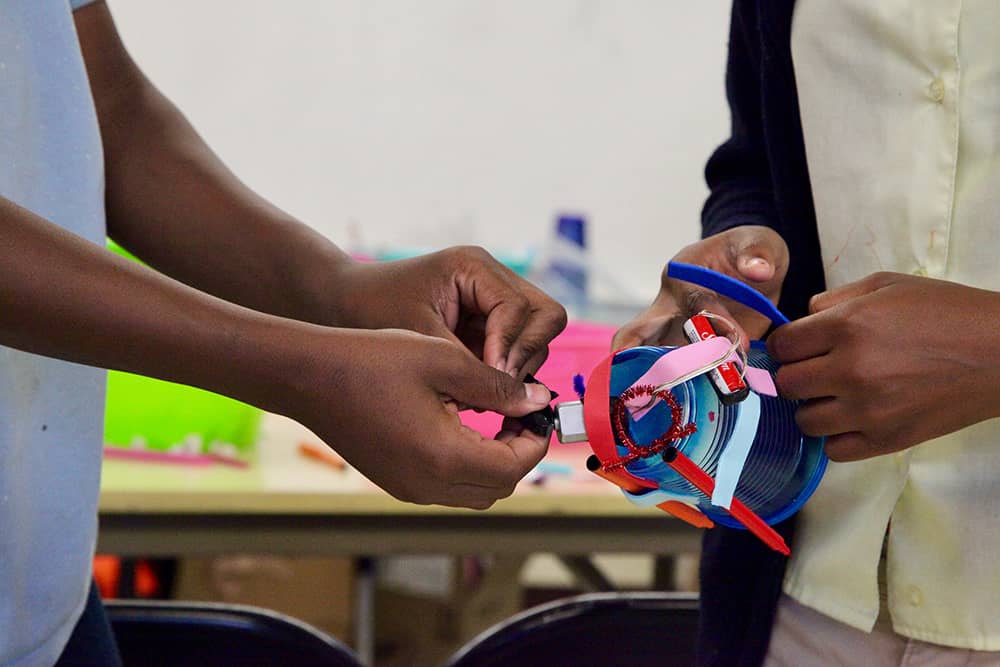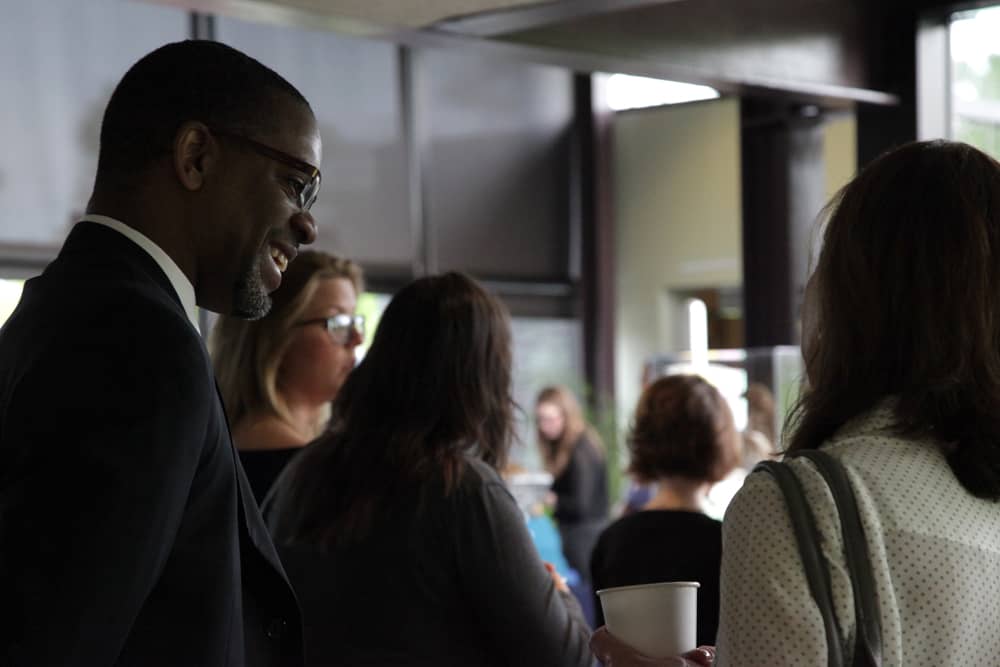Blog
The National Endowment for the Arts: a Sound Investment
Co-authored by Barbara Krebs, a Young Audiences volunteer and Sunburst Society member.
We grow up in the United States hearing that we get what we pay for. Such is the case with investments in the greater good. That’s one of the many reasons we’re so passionate about teaching in and through the arts. From our country’s youngest students to our aging seniors, the entire population benefits in both the short- and long-term from the arts, whether it be emotionally, socially, or intellectually.
Non-profit arts organizations like us work hard to both generate sustainable programming and seek support from private and corporate funders so that we may fulfill our mission to positively impact the greatest number of Maryland children with the highest quality arts-integrated educational programming. Federal funding may only be a piece of our funding picture, but it is an important one.
We are excited and proud that the National Endowment for the Arts awarded Young Audiences of Maryland $90,000– one of only seven total Collective Impact Grants awarded nationwide– for the Arts Empowered Minds Initiative (AEMI) in Northern Anne Arundel County! The Arts Empowered Minds Initiative utilizes arts integration programming to boost achievement, parental involvement, student engagement, and empathy. Programming includes in-school arts integration, out-of-school arts programming, and professional development for teachers. In addition, the program will partner with community organizations to create family engagement opportunities, such as providing family passes to the new Maker Space at Chesapeake Arts Center.
The program is the culmination of the work of many groups and individuals seeking to build a movement for increased equity through the arts in their community. With funding from the NEA in 2016, we built partnerships with Anne Arundel County Public Schools (AACPS), Chesapeake Arts Center (CAC), Arts Education in Maryland Schools Alliance (AEMS), Arts Council of Anne Arundel County, and University of Maryland – Baltimore County (UMBC). Together, we have already provided professional development to over 100 teachers, and delivered high-quality arts-in-education programs to nearly 2,500 students at six schools.
“This second grant from the NEA will allow us to both deepen and expand our reach and maximize existing resources to ultimately bring the impact of arts integration to almost every student in Northern Anne Arundel County,” Stacie Sanders Evans, Executive Director of Young Audiences explained. The Arts Empowered Minds Initiative will expand from six schools to all 12 public schools in Northern Anne Arundel County and impact more than 7,000 students in grades pre-k through 12.
To be clear, it’s not the NEA’s budget that is proposed to be cut; it’s the NEA itself that is on the line. It’s important to think about this as it impacts local communities and groups. And, should the NEA be eliminated, it will impact our community. When vital, far-reaching, and life-altering programs are at risk, we must speak up. And it’s surprisingly simple and quick to let your voice be heard. Identify your legislators. Email your senator. Call your representative. Write a letter.
Take 2 minutes now to contact your members of Congress and join the #SAVEtheNEA campaign. Involved citizens can and do make a difference. Please, join us in the fight to keep the arts alive and accessible in our nation, state, and community. We get what we pay for. And, when we invest wisely, what we get is more than we could have ever even hoped for.
Arts Budgets, Job Creation, and the NEA
Written by Barbara Krebs, a Young Audiences volunteer and Sunburst Society member
With all the talk of entirely eliminating funding for organizations such as the National Endowment for the Arts (NEA) from the federal budget, a recent Washington Post Magazine article caught my attention. The June 11, 2017 issue featured a boldly colored cover and the caption, “Is Arts Funding Essential or Wasteful? We traveled the country to find out.”
I was especially intrigued since one of the arts projects they highlighted was in Wilson, NC – where I lived as a teenager. I admit that I haven’t been back in many years, but I had heard from friends that the town had fallen on hard times as tobacco warehouses (once the backbone of the economy) closed down.
The article opened with the development of Whirligig Park, which is dedicated to the artwork created by Vollis Simpson, who fashioned giant whirligigs out of scrap metal that he collected from his day job of transporting houses and heavy machinery. Before his death in 2013, Simpson had gained quite a following; the man and his artwork had been featured in publications that range from The New York Times, USA Today, The Washington Post, and the Smithsonian Magazine, among many.
As I read the Post article, it highlighted how the NEA had been “an early believer in the civic power of Simpson’s creations.” With the help of the organization and its grants, locals also began seeing the possibilities – to draw tourists and their dollars to Wilson – and skeptics gradually became believers. People who had originally viewed Simpson’s whirligigs as junk now began to see how the arts could help revitalize a moribund downtown.
But just as all politics is local, so too are the arts. You focus on where you live. With that in mind, a quick check of the NEA web site revealed that in the Fall of 2016, 19 grants, totaling $520,000, were awarded to a variety of Maryland arts groups. And while these groups range widely in mission and artistic focus, two things stood out: 1) how many of these groups reach out with the arts to educate and 2) these NEA grants create much-needed jobs.
Over the years NEA support has made it possible for Young Audiences to reach children in every county in our state…
Under the education category, award recipients include the Baltimore Symphony Orchestra’s OrchKids program, which provides Baltimore City Public School students with a music and mentorship program; Wide Angle Youth Media, Inc., which teaches students how to share their voices through media arts education; The National Association of Black Storytellers, Inc., whose Adopt-A-Teller Program places African American storytellers in schools for performances and workshops to share and preserve the rich heritage of the African Oral Tradition; Arts on the Block (AOB) who provides teens in and around Montgomery County real-world work experiences through the arts; and World Arts Focus in Mount Rainier, for a program developed improve the health, identity, and independence of teenagers and adults with autism, Down syndrome, cerebral palsy, or other disabilities through dance.
Over the years NEA support has made it possible for Young Audiences to reach children in every county in our state and has provided consistent support for teaching artist training, ensuring that our programs are not only accessible and affordable to underserved students, but are of high quality and enhance the curriculum of our schools.
What about the job creation category? Here are a few thoughts on the economic impact of the arts in our communities.
- Employment opportunities – we’re not just talking artists and dancers here. The arts also employ carpenters, electricians and many other technical and administrative jobs needed to produce showcases, exhibitions and museum presentations.
- Arts education – at Young Audiences we see every day, firsthand, what a huge impact the arts have in helping students connect to reading, math, and science. Educated youth become educated adults with jobs that create a tax base.
- Tourism – Many struggling small towns, and even larger cities, have boosted the local economy by creating arts zones, which draw in tourists, which, in turn, creates the need for restaurants, hotels, and other tourist-oriented businesses.
So what lesson can we take from all this? I think it is simply that the arts do matter – a lot. The arts help create and maintain vibrant community ties, which in turn translates into real economic impact. Before the Post Magazine article caught my eye, I had read an article in the April 2017 issue of Our State, Celebrating North Carolina. I read about 217 Brew Works, which opened last November, hmm, across the street from Whirligig Park. Tourists certainly enjoy the proximity of the brewery to the park, but more importantly, locals are the true economic boosters – coming down to talk, to relax and to enjoy their community’s new meeting spot.
It’s also worth noting that when the arts are supported, great synergies are created. For example the Our State article ended with, “another developer has moved forward with plans to create Whirligig Station – apartments, restaurants, and some office space – in an empty red-brick tobacco warehouse on another edge of the park.”
Far from being an unnecessary frill as some critics of the NEA portray it, what is readily apparent is how many small communities discovered an economic lifeline from the grants that the NEA provides. The closed factory, the shuttered mill, the abandoned plant are sadly a fact of life in too many small towns. But as many of them have discovered, there are opportunities here as well. Who knows what might happen in your community when you combine artistic vision, a good beer, and an NEA grant?
Coming up on the June edition of smARTbeats on WTMD: pianist and composer Scott Patterson
smARTbeats returns to WTMD this Saturday, June 10, during the weekly children’s music program Young At Heart. On this month’s smARTbeats segment, Young At Heart host Lisa Mathews sits down for a chat with Scott Patterson, pianist, composer, YA teaching artist, and co-founder and Artistic Director of Afro House, a music-driven performance art house based in Baltimore.
During the segment, you’ll hear Scott Patterson’s luxuriant blend of classical, soul and rock music, which Pittsburgh Tribune-Review describes as “a masterly blend of virtuosity, singing style and beautiful voicing” and learn about his work as a performing and teaching artist, and how the arts can impact the lives and education of children.
“As a performer and composer, I put my entire being, passion, and skills into telling a story.” Scott says, “Doing so enables me to take the audience on a journey to transcend limitations and transform the heart. My approach to creating and performing extends to my work in schools. As a teaching artist, I have seen firsthand the positive impact of arts education on students.”
In schools, Scott Patterson welcomes students into his assembly performance Outer Space Improvisations with the sounds of space, immersing students in original space-themed compositions inspired by composers and artists such as Beethoven, Liszt, Earth, Wind & Fire, Led Zeppelin, Jimi Hendrix, Maroon 5, and Bruno Mars. To expand the connection, facts about space are woven in throughout the program to deepen their intergalactic experience.
Patterson says one of the reasons he joined the Young Audiences teaching artist roster was a fond memory of the school assemblies he attended as a child. “Whether the assembly was about public safety or a performance, the message always stuck with me. Assemblies were presented as something special, a time to get out of the classroom and see information presented in a fun and interesting way. It is my hope that Outer Space Improvisations leaves the same kind of positive impression on students as the assemblies I attended as a child.”
“Through music,” Scott says, “I encourage students to see the convergence of academic disciplines, rather than single out one in particular. In using improvisation activities, I invite students to pull from what they know about math, literature, science, and history to create something entirely new and unique.”
As a performing artist and co-founder and Artistic Director of Afro House, Patterson and his team are “committed to the development of a music culture that is disruptive, exuberant, innovative, emergent, and transformative.” At the center of Afro House stands the Astronaut Symphony, a contemporary music ensemble that creates symphonic performance art pieces, such as Patterson’s sci-fi tone poem, Ebon Kojo: The Last Tribe. Recently, the Astronaut Symphony was in residence at Single Carrot Theatre and NextLOOK and most recently performed during Nights on the Fringe at The Baltimore Theatre Project.
A Piano Performance major, Patterson studied under Richard Fields at the University
of Cincinnati’s College-Conservatory of Music and Phillip Kawin at the Manhattan School of Music.
Young At Heart airs weekly from 7 to 8 am on Saturdays, featuring music that appeals to parents and children alike. Previous shows have featured music by Wilco, David Bowie, Andrew & Polly, Weezer, and others.
Hear YA teaching artist and composer Scott Patterson online now!
Congratulations TAI Graduates!
We all know that artists can change the world. The Summer Arts & Learning Academy is proof of that. The Teaching Artist Institute (TAI) helps give artists the tools they need to do it.
“Participating in TAI allowed me to look past what was most commonly done, embrace my artistic instincts, and focus on what really matters,” said Maura Dwyer, one of the Teaching Artist Institute’s newest graduates. “Instead of teaching students how to paint, I am teaching them how to think visually.”
During the course of the programs, artists worked with classroom teachers to design arts-integrated and Common Core-aligned fine arts programs for schools. Each TAI team designs and implements an artist-in-residence program in which teachers gain arts skills and artists gain valuable teaching skills. Topics such as classroom management strategies, designing, writing, and teaching artist-in-residence lessons, and educator needs are covered, as well as opportunities for field testing and feedback.
Congratulations to the following artists and teacher partners who completed the TAI seminars in May 2017!


Next summer we are going to need even more qualified teaching artists to work at our academy. Apply to the Teaching Artist Institute by Friday June 9 to be trained and considered for summer 2018! New artists who successfully complete TAI, graduate from the program, and meet additional requirements, will not only be hired for our summer program, their tuition will be reimbursed!
Changing Perceptions: I Used to Think…
Written by Barbara Krebs, a Young Audiences volunteer and Sunburst Society member.
Colorful sticky notes adorned the walls of the classroom. Like before-and-after photos of an amazing remodel, the notes told the story of how a group of Head Start teachers in Southern Maryland unveiled their hidden talents to reach their young students through the arts. The ‘before’ stickies began, “I used to think…” Teachers filled in the rest of the sentence with thoughts such as, “dance, music and theatre weren’t that effective,” or “movement and story time could not go together,” and “it was hard to integrate the arts into the classroom.”
Then, as Young Audiences teaching artists demonstrated techniques that blend learning and the arts, the Head Start classroom teachers began making their own artistic/educational connections – connections that would help them return to their classrooms and engage kids in ways they had been hesitant to trust before. They soon realized that when kids are singing, dancing, and moving, it’s easy for them to forget that they’re actually learning!

The Professional Development course was held on February 17th and sponsored through the PNC Grow Up Great® initiative. Created to help children from birth through age five develop a passion for learning that lasts a lifetime, the program generously funded training that provided Head Start teachers with a variety of resources to increase learning, engagement and confidence by incorporating art into the curriculum.
Three YA teaching artists, musician Lisa Mathews, actor Khaleshia Thorpe-Price, and dancer Anna Menendez, taught the group. They learned, for example, how to use dance tools to create patterns, how to use their bodies and musical instruments to express themselves, and how the use of props and different character voices can more fully engage students in story time. At the end of the class, each teacher was tasked with writing and presenting a lesson seed in each art form for when the class reassembled in May.

“It was very evident from their participation on the first day and their reflections on the second day that teachers were excited about these arts strategies and implemented them immediately,” explained Kristina Berdan, YA’s Education Director. “Having strong backgrounds in social and emotional learning, they were able to quickly experience and understand the impact that the arts can have on this kind of growth in young people. Most of them tap into the arts regularly through chants and songs, yet these professional development opportunities allowed them to learn deeper, more meaningful strategies in and through the arts. The ‘ah-ha’s and feelings of excitement were palpable!”

For some, wariness about the role arts could play in the classroom had been replaced with a newfound willingness to incorporate them into their lesson plans. Through the introduction of dramatic play and puppetry, for example, students had a greater understanding of the stories they read in class than they did before the professional development course. One Head Start teacher, Jessica Wiley, summed up her experience in YA’s Professional Development class this way, “The ideas and suggestions were practical, applicable, and personalized. I love how Young Audiences was able to address our questions, challenges and concerns very well.”
The teachers ended the day completing sentences on sticky notes that began, “Now I think…” Their statements showed how their opinions about using the arts as a tool for learning had evolved from hesitancy to a feeling of openness and anticipation, writing, “you can use music in all areas of teaching,” and “dance can be a calming technique,” or “movement in story time is helpful to keep children engaged.”
For Maryland’s youngest students, the new strategies will be especially impactful. “Head Start supports our nation’s most vulnerable children by offering a comprehensive, high quality early-learning experience that prepares them for kindergarten and strengthens family participation in their children’s learning,” said Yasmina S. Vinci, executive director, National Head Start Association.
Like any successful renovation, the before-and-after sticky notes showed what can be created when you effectively blend harmonious elements – education and the arts – to capture a child’s natural desire to learn.
Baltimore City’s First Bloomberg Arts Internship Recipients Announced
The Bloomberg Arts Internship program is coming to Baltimore this summer, placing 25 Baltimore City rising seniors in paid internships at 14 local arts and cultural institutions. Students will participate in a rigorous six-week program, providing crucial college and career readiness preparation through hands-on, real world workplace experiences and professional development.
Managed by Young Audiences/Arts for Learning and the Greater Baltimore Cultural Alliance (GBCA), the program includes work at an arts organization, visits to arts and cultural organizations, and professional development training. The Baltimore Bloomberg Arts Internship Program runs June 20-August 4, with Baltimore being the third city to host the program along with New York City and Philadelphia.
Participating institutions include performing arts centers focusing on dance and music, art museums, libraries as well as film festivals and television studios. The organizations welcoming Bloomberg Arts Interns include:
Baltimore Center Stage
Baltimore Museum of Art
Baltimore Symphony Orchestra
Center for Innovation, Research and Creativity in the Arts (CIRCA) – UMBC
Dance & BMore
Everyman Theatre
Hippodrome Foundation, Inc.
Maryland Film Festival
Maryland Institute College of Art (MICA)
Maryland Public Television
Peabody Institute of The Johns Hopkins University
Port Discovery Children’s Museum
The Reginald F. Lewis Museum of Maryland African-American History & Culture
Sheridan Libraries and University Museums, Johns Hopkins University
“Through our arts internship program, we’re working to change how the next generation of employees and leaders perceive cultural institutions’ contributions to a city’s workforce, economy, and identity,” said Patricia E. Harris, CEO of Bloomberg Philanthropies. “As part of the program, interns will develop critical workforce skills at select non-profit cultural organizations, meet with professionals in the field, and attend career and college readiness workshops as part of their summer experience. We are delighted to expand this program to Baltimore.”
The 25 Bloomberg Arts Internships interns were selected through a multi-step application and interview process. They will work with arts organizations three days a week, go on field trips to cultural institutions once a week, and engage in professional development trainings once a week. Through the internships and trainings, students will develop organizational work plans, begin their college applications, write analyses of art performances, and complete final projects on their experiences. Internship focuses vary across organizations to include production, education, development, community engagement, artist engagement, video, music, administration and more.
“The arts have the power to transform lives and the futures of students in our community,” said Stacie Sanders Evans, Young Audiences Executive Director. “Through their generous investment in Baltimore, it is clear that Bloomberg Philanthropies not only agrees, but also can see the vibrant, growing community of artists and organizations that make this city unique. We’re thrilled to coordinate this wonderful opportunity, providing Baltimore students with experiences showing the arts as a viable career pathway and passion. We can not wait to see how this program impacts the ideas and dreams of these interns.”
“GBCA is excited to be part of this new project,” said Jeannie Howe, GBCA Executive Director. “The Bloomberg Arts Internships will help young people develop workforce and college preparation skills, and support an equitable pipeline for talented young people interested in careers in arts and culture. The cohort in turn, many of whom are of color, will help strengthen the equity and inclusion of Baltimore’s wonderful and diverse arts organizations.”
Baltimore Bloomberg Arts Interns come from schools across the city, including REACH! Partnership School, Baltimore City College, Western High School, Ben Franklin High School, Patterson High School, Baltimore School for the Arts, City Neighbors Charter School, Baltimore Design School, Digital Harbor High School, Bard High School Early College, and Mergenthaler Vocational Technical High School.
What Students Learn from an Artist in Residence Program: Cooperation and Perseverence
Step into a FutureMakers workshop, and you are immediately met with bright colors, texture, and sound! The room is a symphony of whirring and spinning, and you can almost hear the busy minds buzzing. This is exactly the scene in the art room when FutureMakers coaches Topher and Ross taught a series of workshops at Gardenville Elementary recently.
Thanks to programs like the Access for All Initiative and Maryland State Arts Council (MSAC) Artist in Residence (AiR) grant, more and more schools are able to bring the high-quality STEAM programming that FutureMakers provides into their classrooms. “We’re so happy to see so many schools leveraging resources from the Maryland State Arts Council,” FutureMakers founder Matt Barinholtz told us. “In 2017, we served nearly 1000 Maryland students through AiR programs – all who were able to increase their understanding of the engineering design process, circuits and visual arts elements by creating artworks that are designed and built to move!”
The goal of each workshop was for every student to create a drawing machine: a small, unique, motorized tripod that doodles and draws as it swirls and whirls across a flat surface. But it would be a mistake to assume that the finished product that students carry away is the only benefit to the session. FutureMakers teaches kids that engineers cooperate and persevere—skills that will take students far.

Coach Topher raised his hand at the front of the classroom and asked, “Who here has ever made something before?” The kids were excited. Some of the materials they received to build their machines, they recognized. Some, they did not. All of them, they had to connect and make work.
Problem-solving and troubleshooting are easy to talk about. “It’s easy to say, ‘try your best,’ but in the moment, it’s the most frustrating thing.” Connecting batteries to motors and transforming them into pieces of art takes patience and skill. “Engineers fix stuff. Usually, they’re fixing stuff they mess up themselves!”


 Though students all started on the same path, each robot took on its own distinct personality. Students directed the design of their bots, testing and retesting to see how design elements worked with the functionality of their machines. Through problem solving and teamwork, the young engineers found success.
Though students all started on the same path, each robot took on its own distinct personality. Students directed the design of their bots, testing and retesting to see how design elements worked with the functionality of their machines. Through problem solving and teamwork, the young engineers found success.

“FutureMakers knows that integrating quality STEAM programs is essential – and requires support,” said Barinholtz. Funding is available for schools and community organizations that can help all children experience high-quality arts programs.
Bring FutureMakers into your school with the help of a Maryland State Arts Council (MSAC) Arts in Education (AiE) grant. The MSAC AiE grant will fund up to 30% of the total cost of a YA residency program, including travel costs. The deadline to apply is Friday, May 19, 2017, by 5 pm. Start the application process today.
Our Board of Directors: Bravely Creating Opportunities for our Students
We are reminded every day of the irreplaceable support we receive from those who share in our mission to transform the lives and education of Maryland students through arts experiences. From teachers and teaching artists to principals, parents, and donors, our list of allies is long. And because of our allies, the reach of our impact is wide and growing even wider.
“Thanks to our amazing staff and board, and to our supporters, including our Sunburst Society, our outreach has grown by 400%,” executive director, Stacie Sanders Evans, announced at the crowded Impact Breakfast last week. “Last year, we reached 191,000 students at nearly 500 schools with 225,000 hours of inspired learning! Also, we trained 1,096 teachers in arts-integrated instruction – so that means this kind of learning takes place even when our artists aren’t in schools.”


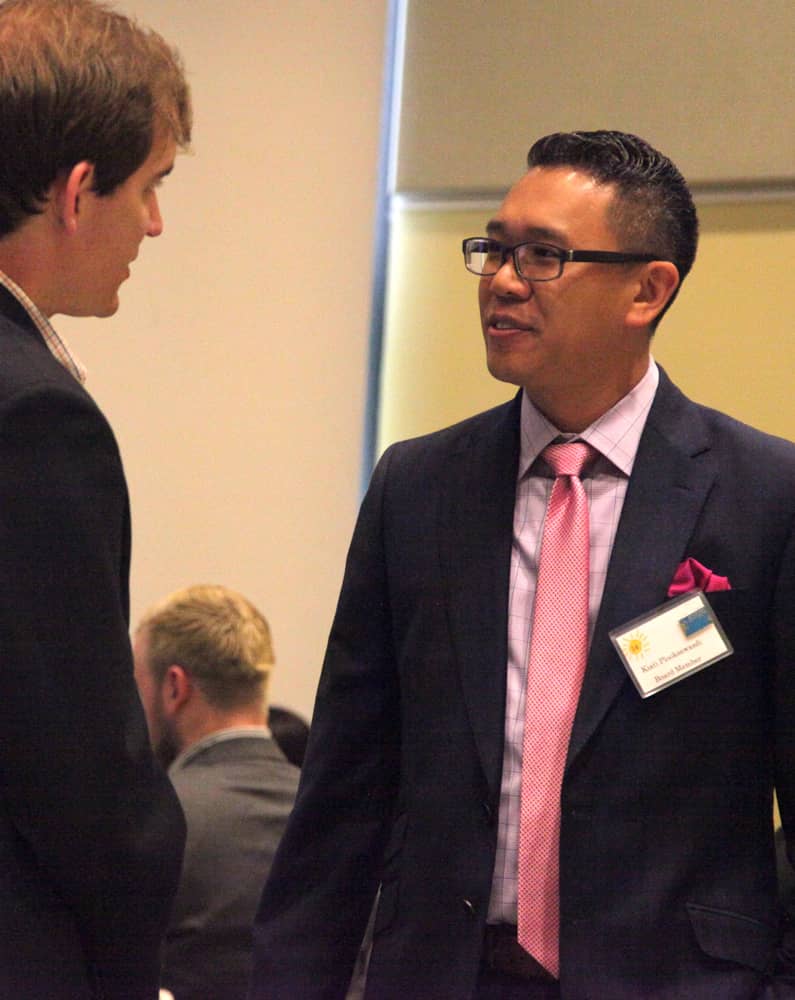

Our teaching artists live and breathe our mission through their work in classrooms every day. And that’s just the beginning. While they may fly under the radar, our board of directors includes 23 of the most engaged, hands-on leaders and supporters we could hope for. Their commitment is extraordinary. Our board members can be found supporting our work in any number of ways including authoring blog posts, hosting On The Brightside events or leading full-day staff and teaching artist trainings. You may find them meeting with potential sponsors over lunch, inviting colleagues to our events, learning dance routines with their co-workers from a teaching artist, or even volunteering to make sock-puppets at our Family Engagement Night!


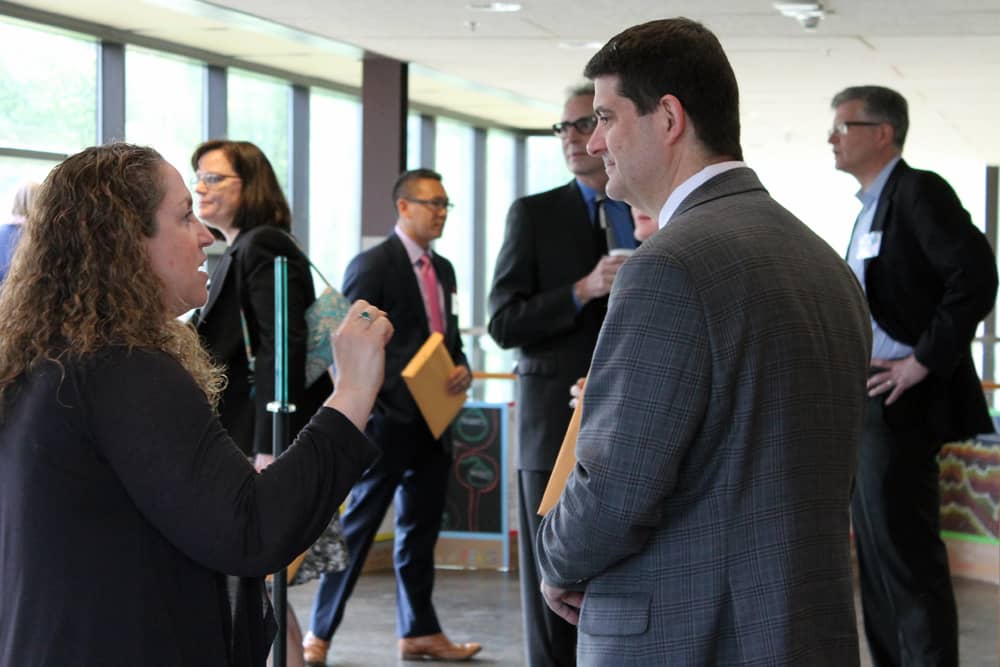
Our board members are proud of the work we all do and they are eager to say so. “Arts integration is when the arts are drilled down into an academic curriculum in a thoughtful and meaningful way – and that is what puts the ‘Arts for Learning’ in our name and what makes Young Audiences/Arts for Learning so exceptional,” explained board member Tea Carnell at the Impact Breakfast. “What do the arts bring to a curriculum? Creativity, joy, and expression are the obvious ones. Arts integration brings mastery, perseverance, insight, focus, understanding, reflection, and problem solving.”
It is this passion for arts integration and the desire to reach all children that drives each one of us at Young Audiences, but we wouldn’t be able to do the work we do, and we wouldn’t be able to reach the children we reach, without the unwavering support of our board members. “We are at this incredible moment in time. We have the evidence our programs work. We have a school system that is asking for help. All we need to do is bravely create the opportunities we know students need,” Stacie Sanders Evans told supporters. “Young Audiences, its incredible artists, everyone in this room – YOU – can close the gaps for our young people.”
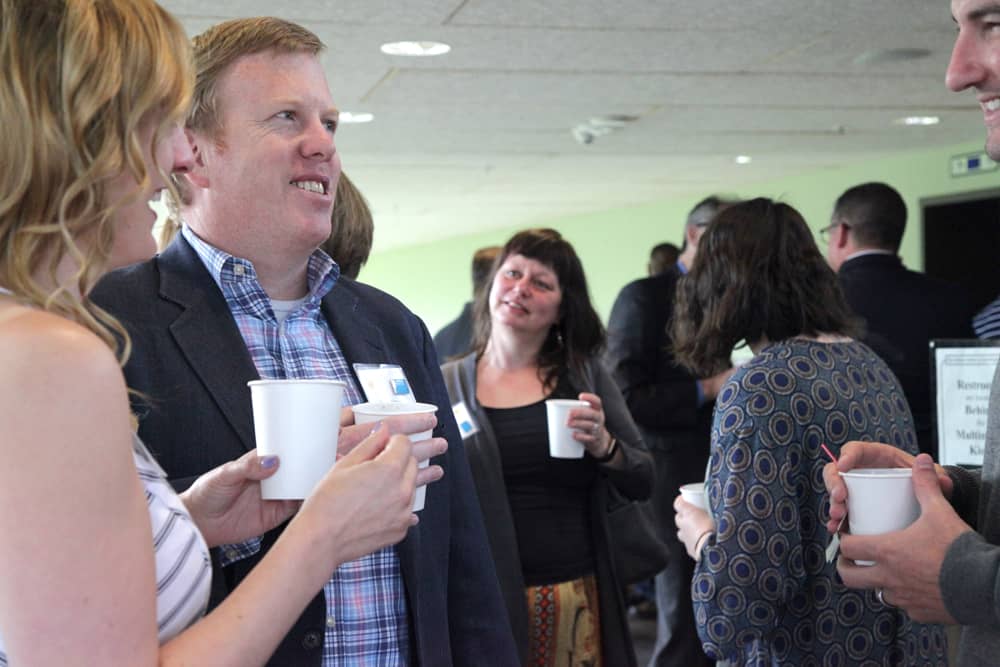
And you are. Because of you, we not only met, we surpassed our Impact Breakfast’s fundraising goal. From the bottom of our hearts, we extend a sincere thank you to our board, to Alan Hoff, chair of our major gifts committee, and to each and every one of our wonderful supporters. Visit yamd.org to learn more about the programs we offer and how you can help us reach even more children.
smARTbeats on the Radio

At Young Audiences, we are transforming the lives and education of young people through the arts by connecting educators, professional artists, and communities. Our roster artists use music, dance, visual arts, and theater to bring classroom lessons to life and empower students to think creatively and engage in the learning of all subjects in different ways. All of this contributes to joyful, creative, and impactful learning experiences in schools. Together, we are sparking imagination, energizing classrooms and giving children the tools they need to build, collaborate and thrive.
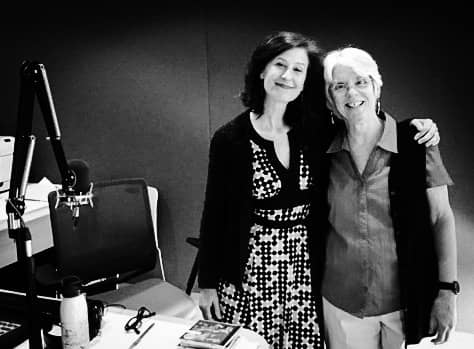
We are thrilled to announce a new partnership with WTMD to feature YA teaching artists on their new radio show Young At Heart, airing Saturday mornings! Beginning May 6, host Lisa Mathews—YA teaching artist and lead singer of Grammy-nominated children’s band Milkshake—will chat with YA roster musicians on a monthly segment called smARTbeats. Listeners will learn about the artists’ work, arts integration, and how the arts can reach students in the classroom.
“For me, songwriting with young people is STILL an exuberant experience – focused and playful, challenging and collaborative – and deeply satisfying for me.”
The series will begin with YA teaching artist and musician Sue Trainor. In the classroom, Sue teaches students to use songwriting as a tool to remember content. In the studio, her compositions are playful and fun – the kind of tunes that you can’t help but smile when you hear, with the kind of lyrics you won’t forget. “As a young person, I was captivated by the songwriting process. Musical jams with other kids were exuberant experiences,” Sue says, “For me, songwriting with young people is STILL an exuberant experience – focused and playful, challenging and collaborative – and deeply satisfying for me.”
“I’d like to think we’re at our best when we’re young at heart — when we have a youthful outlook on life no matter what our age,” host Lisa Mathews told WTMD. “I still like to ride the roller coaster, jump in rain puddles and eat toasted marshmallows. So listening to songs about taking a trip into space or the wonders of rainbows or eating lots of grapes rocks my world, and I hope it makes listeners smile while they start their day together.”
Young At Heart airs weekly from 7 to 8 am on Saturdays, featuring music that appeals to parents and children alike. Previous shows have featured music by Wilco, David Bowie, Andrew & Polly, Weezer, and others.
Hear YA teaching artist and songwriter Sue Trainor online now!
Growing Up Green at Mount Rainier Elementary School
Children in Prince George’s County Public Schools know how to celebrate Earth Day! Through Growing Up Green, a PGCPS arts integration initiative, children in kindergarten classrooms learn environmental stewardship by experiencing nature first-hand, marveling in the wonders of our natural world, and nurturing a passion within themselves to respect and preserve it. Funded in part by a BGE Green Grant and the Chesapeake Bay Trust, the program engages kindergarteners in meaningful and authentic outdoor experiences that help connect them to their local ecosystems and inspire them to learn more about protecting our environment. The arts provide the vehicle that the students use to demonstrate and communicate their understanding to the greater learning community of their school.

At Mount Rainier Elementary School recently, YA roster artist Pam Negrin worked with young students to record their own observations of plant life over the course of her residency, The Life Cycle of Plants. On outdoor adventures, the class immersed themselves in the drama of nature. They set out to identify and explore the many characteristics of plant life in all of its forms: seeds, seedlings, mature plants, flowers, and fruit. Their drawings and observations were then rendered in colorful yarn, stitch by stitch into one large-scale embroidered mural for their entire school community to learn from and enjoy.

The children’s work serves as a reminder of one of the biggest lessons even our smallest students can teach us. Just as this kindergarten class’ finished mural is a collaborative effort, so is making our world a safe, strong, and healthy one for every living being. Happy Earth Day to all.
Pam Negrin’s artwork includes embroidery, appliqué, drawing, collage, improvisational quilting, printmaking and sculpture. Her residencies transform classrooms into creative and collaborative handwork studios where students create something beautiful together. Schedule one of Pam’s residencies for your classroom.
Planning for Excellence at Baltimore Design School
Before there is art, there is planning- lots of planning. This is something that 7th graders at the Baltimore Design School know all too well. Without it, the mural that these students created under the guidance of YA roster artist Amanda Pellerin and art teacher Stephanie Cafaro would not be the magnificent work that it is.
The class began with brainstorming and list-making. “We asked the students, “What’s important to you?” Amanda Pellerin explained, “And we had different posters that asked, “What’s important to you at home? What’s important to you at school? What’s important to you in your city? What’s important to you in the world?”
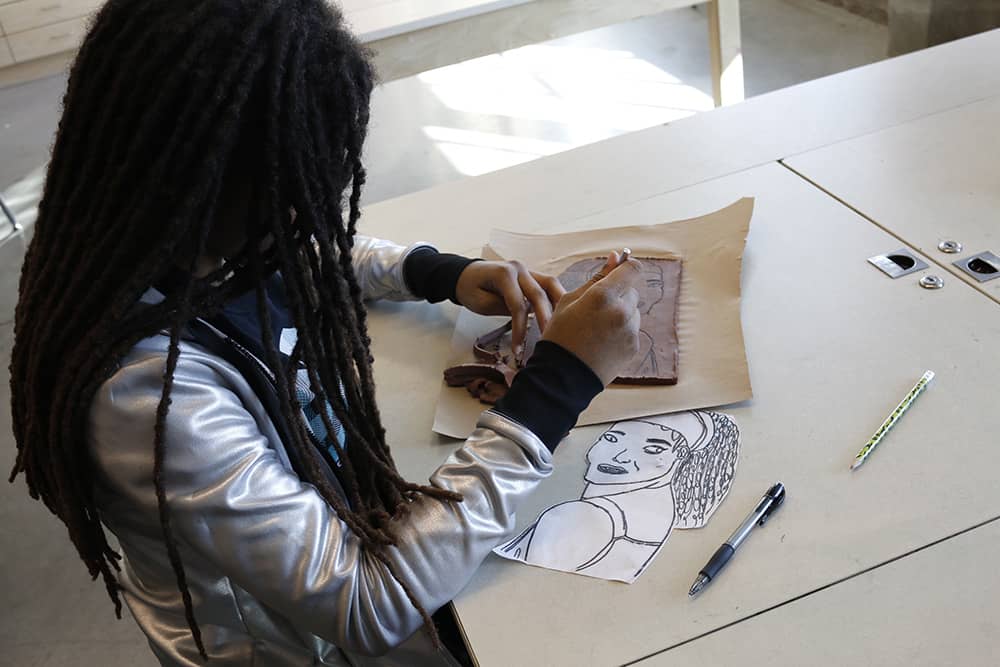
From these ideas, Miss Cafaro had the students narrow down what they believed to be most important into one list of possible mural themes. Some suggested a tribute to President Obama or a better Baltimore. Others wanted to illustrate the power of protesting or important issues in the world today. “When I looked at this, I didn’t see 10 different murals,” Pellerin said. So, the artist proposed combining each idea into one single, powerful mural, and the students were all for it.

Before they could get to work on cutting and etching and glazing their tiles, however, the group first had to decide what the project was going to actually look like. After discussing composition and scale, and considering how the piece would flow visually, the group decided that the mural would feature three “larger than life” role models among a crowd of protesters. The class felt that President Obama, Harriet Tubman and a native American should stand out. The choices that the class made in the design process were purposeful. Role models weren’t chosen randomly, they were justified and carried significance for each student.

Small teams of students worked together to create each larger than life figure, then reunited to complete the picture and piece the mural together. In their finished artwork, historic role models protest alongside important figures of the present. The figures carry protest signs that reflect current issues with sentiments that students imagined each role model might express if given the chance today.
“We’re trying to help them understand that designers work as teams.“
From conception to execution, the class was instrumental in seeing the project to completion. Directing the vision of the finished piece allowed the students to take ownership of the artwork and truly see it as their project. “I love that they had to come up with a concept and work together,” noted Miss Cafaro. Every material that needed to be prepped and every decision that needed to be made happened because the class took charge, collaborated, and cooperated. “We’re trying to help them understand that designers work as teams,” Miss Cafaro said. “Even if it’s not their favorite idea, they’re part of a team and still need to contribute.”
Amanda Pellerin specializes in handmade tile murals and clay sculptures and has 20 years of experience in teaching both children and adults. Learn how to bring Amanda’s residency, Handmade Tile and Mosaic Murals, into your school.
The Power of TAI: Transforming Education Through the Arts
Teaching artists are expertly trained to deliver and coordinate unique, age-appropriate, and high-quality lessons alongside classroom teachers at the Teaching Artist Institute (TAI). The program is a partnership between Young Audiences, the Arts Education in Maryland Schools Alliance (AEMS), and the Maryland State Arts Council (MSAC) that turns professional artists into teaching artists and offers experienced teaching artists new strategies for everything from classroom management to designing artist-in-residence lessons.
“You might find yourself ‘shocked’ at how much electricity comes from the marriage of art and education!”
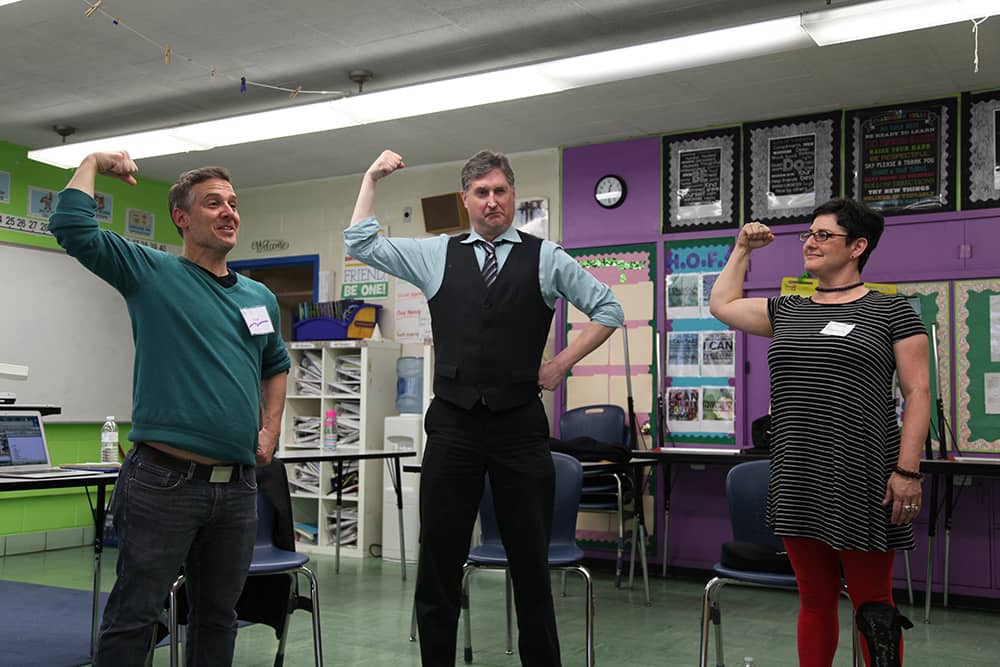
The positive effects of arts-integrated curricula in individual classrooms, and on teachers, students, and families are numerous and extraordinary. Teaching core subjects through the arts can increase student engagement and understanding. It can direct a classroom culture toward tolerance and empathy and it can even rejuvenate teachers and bring joy and anticipation to the faculty!

“Through its audacity, its abstractions, its “aliveness,” art activates parts of the brain that any teacher or employer should want to turn on,” notes Drew Anderson, a veteran school teacher and YA roster artist. “You might find yourself “shocked” at how much electricity comes from the marriage of art and education!”

Teachers, families, and artists of all ages got a small taste of several teaching artists’ lessons during an afternoon at Southwest Baltimore Charter School. Participants spent their time exploring new skills and practicing old ones with: Performing artist and YA roster artist, Drew Anderson; Illustrator and new YA roster artist, Maura Dwyer; Illustrator, animal rescuer and new YA roster artist, Brittany Roger; Actor, Michael Hartwell; Actor, Tori Bertocci; Actor, Dave LaSalle; Actor, Cori Daniel; and Ceramicist and new YA roster artist, Mama Sallah.
They sculpted clay, interpreted music through movement and acting, sketched and learned about reptiles with a live chameleon, created collage utilizing different design elements, and learned awesome animal facts through improvisational theatre. One young participant was overheard telling her friend about Cori Daniel’s acting workshop, “It was so cool! We told stories with Ms. Cori without actually saying any words!” We can’t wait to hear about the wonderful classroom experiences and learning opportunities these teaching artists help to create!

TAI is proud to be helping build a community of artists, teachers, and leaders who are committed to transforming education through the arts. Artists interested in designing lesson plans or teaching artist-in-residence programs should apply to this rigorous and renowned program. There are many things about TAI that make this professional development course unlike any other including mentorship from a designated teacher partner and from a master teaching artist in your art form. Not to mention, graduates of TAI have the opportunity to be considered for both the Maryland State Arts Council Artist in Residence Roster, and the Young Audiences/Arts for Learning Teaching Artist Roster!
For more information about the Teaching Artist Institute including videos, pricing and how to apply, click here. Read what artists are saying about the program on our testimonials page.











